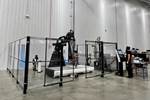CEAD print bed anchors ensure first layer adhesion in large-format 3D prints
Reusable plugs insert into CEAD’s patent-pending print bed, enable locking of first layer and easy release once printing is finished.
CEAD’s reusable plastic print bed plugs (blue) channel extruded material to create anchors ensuring first layer stability. Source (All Images) | CEAD
CEAD (Delft, Netherlands) provides a range of technology solutions for composites additive manufacturing (AM), including pellet extruders, gantry- and robot-based printing systems, rotary tables, robot rails and now, innovative print bed and anchoring solutions.
CEAD’s patent-pending print bed platform consists of an aluminum base, which can feature an aluminum plate mounted on top of the frame and heated up to 120°C for materials that require a more gradual cooling process.
The print bed has a modular build. This enables the standard 2 × 1-m platforms to be joined to create a larger print bed. This enables companies to start with a smaller system and then easily expand over time.
This system also uses print bed plugs — reusable plastic anchors that serve to channel extruded print material from the first layer to create a mechanical bond with the aluminum print bed platform. Thus, each print is securely fastened using consistent hooks made from the printing material itself. These reusable plastic plugs enable optimal stability and reliability from the print’s start to finish — and despite their firm grip, completed parts are reported to release effortlessly post-print.
“First-time-right adhesion is guaranteed with this table and plug system for reliable production and seamless 3D printing at scale,” says Maarten Logtenberg, CEAD co-founder and CTO.
Related Content
-
Plant tour: Joby Aviation, Marina, Calif., U.S.
As the advanced air mobility market begins to take shape, market leader Joby Aviation works to industrialize composites manufacturing for its first-generation, composites-intensive, all-electric air taxi.
-
Plant tour: Spirit AeroSystems, Belfast, Northern Ireland, U.K.
Purpose-built facility employs resin transfer infusion (RTI) and assembly technology to manufacture today’s composite A220 wings, and prepares for future new programs and production ramp-ups.
-
Jeep all-composite roof receivers achieve steel performance at low mass
Ultrashort carbon fiber/PPA replaces steel on rooftop brackets to hold Jeep soft tops, hardtops.


















